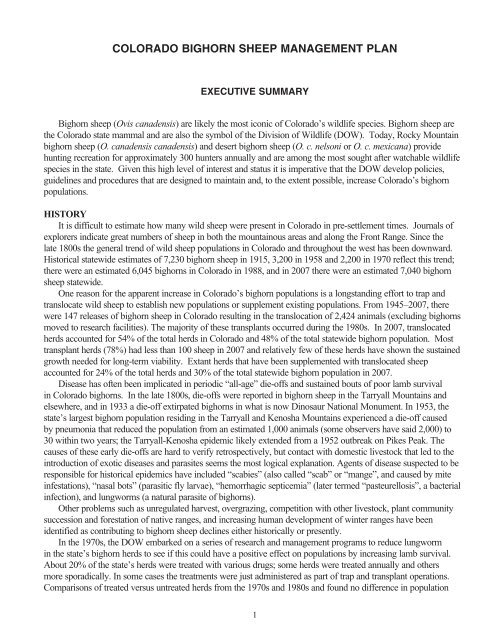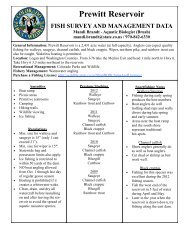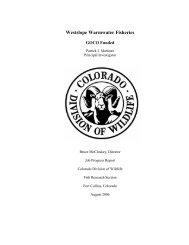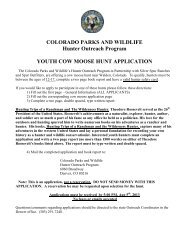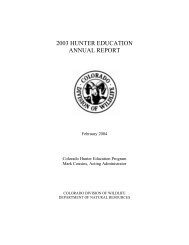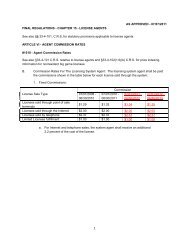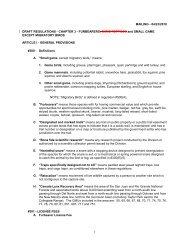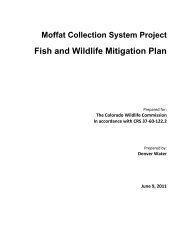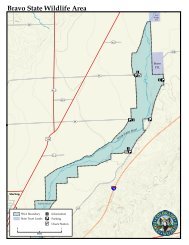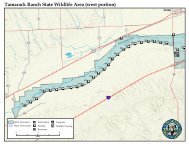COLORADO BIGHORN SHEEP MANAGEMENT PLAN 2009−2019
COLORADO BIGHORN SHEEP MANAGEMENT PLAN 2009−2019
COLORADO BIGHORN SHEEP MANAGEMENT PLAN 2009−2019
Create successful ePaper yourself
Turn your PDF publications into a flip-book with our unique Google optimized e-Paper software.
<strong>COLORADO</strong> <strong>BIGHORN</strong> <strong>SHEEP</strong> <strong>MANAGEMENT</strong> <strong>PLAN</strong><br />
EXECUTIVE SUMMARY<br />
Bighorn sheep (Ovis canadensis) are likely the most iconic of Colorado’s wildlife species. Bighorn sheep are<br />
the Colorado state mammal and are also the symbol of the Division of Wildlife (DOW). Today, Rocky Mountain<br />
bighorn sheep (O. canadensis canadensis) and desert bighorn sheep (O. c. nelsoni or O. c. mexicana) provide<br />
hunting recreation for approximately 300 hunters annually and are among the most sought after watchable wildlife<br />
species in the state. Given this high level of interest and status it is imperative that the DOW develop policies,<br />
guidelines and procedures that are designed to maintain and, to the extent possible, increase Colorado’s bighorn<br />
populations.<br />
HISTORY<br />
It is difficult to estimate how many wild sheep were present in Colorado in pre-settlement times. Journals of<br />
explorers indicate great numbers of sheep in both the mountainous areas and along the Front Range. Since the<br />
late 1800s the general trend of wild sheep populations in Colorado and throughout the west has been downward.<br />
Historical statewide estimates of 7,230 bighorn sheep in 1915, 3,200 in 1958 and 2,200 in 1970 reflect this trend;<br />
there were an estimated 6,045 bighorns in Colorado in 1988, and in 2007 there were an estimated 7,040 bighorn<br />
sheep statewide.<br />
One reason for the apparent increase in Colorado’s bighorn populations is a longstanding effort to trap and<br />
translocate wild sheep to establish new populations or supplement existing populations. From 1945–2007, there<br />
were 147 releases of bighorn sheep in Colorado resulting in the translocation of 2,424 animals (excluding bighorns<br />
moved to research facilities). The majority of these transplants occurred during the 1980s. In 2007, translocated<br />
herds accounted for 54% of the total herds in Colorado and 48% of the total statewide bighorn population. Most<br />
transplant herds (78%) had less than 100 sheep in 2007 and relatively few of these herds have shown the sustained<br />
growth needed for long-term viability. Extant herds that have been supplemented with translocated sheep<br />
accounted for 24% of the total herds and 30% of the total statewide bighorn population in 2007.<br />
Disease has often been implicated in periodic “all-age” die-offs and sustained bouts of poor lamb survival<br />
in Colorado bighorns. In the late 1800s, die-offs were reported in bighorn sheep in the Tarryall Mountains and<br />
elsewhere, and in 1933 a die-off extirpated bighorns in what is now Dinosaur National Monument. In 1953, the<br />
state’s largest bighorn population residing in the Tarryall and Kenosha Mountains experienced a die-off caused<br />
by pneumonia that reduced the population from an estimated 1,000 animals (some observers have said 2,000) to<br />
30 within two years; the Tarryall-Kenosha epidemic likely extended from a 1952 outbreak on Pikes Peak. The<br />
causes of these early die-offs are hard to verify retrospectively, but contact with domestic livestock that led to the<br />
introduction of exotic diseases and parasites seems the most logical explanation. Agents of disease suspected to be<br />
responsible for historical epidemics have included “scabies” (also called “scab” or “mange”, and caused by mite<br />
infestations), “nasal bots” (parasitic fly larvae), “hemorrhagic septicemia” (later termed “pasteurellosis”, a bacterial<br />
infection), and lungworms (a natural parasite of bighorns).<br />
Other problems such as unregulated harvest, overgrazing, competition with other livestock, plant community<br />
succession and forestation of native ranges, and increasing human development of winter ranges have been<br />
identified as contributing to bighorn sheep declines either historically or presently.<br />
In the 1970s, the DOW embarked on a series of research and management programs to reduce lungworm<br />
in the state’s bighorn herds to see if this could have a positive effect on populations by increasing lamb survival.<br />
About 20% of the state’s herds were treated with various drugs; some herds were treated annually and others<br />
more sporadically. In some cases the treatments were just administered as part of trap and transplant operations.<br />
Comparisons of treated versus untreated herds from the 1970s and 1980s and found no difference in population<br />
1


